
Publication 1769-IN032A-EN-P - April 2003
Installation Instructions
Compact 32-point 24V dc Sink/Source
Input Module
Catalog Number 1769-IQ32
Use this document as a guide when installing a Compact™ 32-point 24V dc sink/source
input module.
Topic Page
Important User Information 2
Module Description 3
Module Installation 4
System Assembly 5
Mounting Expansion I/O 6
Replacing a Single Module within a System 8
Field Wiring Connections 9
I/O Memory Mapping 12
Spare/Replacement Module Parts 12
Specifications 13
Hazardous Location Considerations 15
For More Information 16

2 Compact 32-point 24V dc Sink/Source Input Module
Publication 1769-IN032A-EN-P - April 2003
Important User Information
Because of the variety of uses for the products described in this publication, those responsible for the
application and use of these products must satisfy themselves that all necessary steps have been taken to
assure that each application and use meets all performance and safety requirements, including any applicable
laws, regulations, codes and standards. In no event will Rockwell Automation be responsible or liable for
indirect or consequential damage resulting from the use or application of these products.
Any illustrations, charts, sample programs, and layout examples shown in this publication are intended solely
for purposes of example. Since there are many variables and requirements associated with any particular
installation, Rockwell Automation does not assume responsibility or liability (to include intellectual property
liability) for actual use based upon the examples shown in this publication.
Allen-Bradley publication SGI-1.1, Safety Guidelines for the Application, Installation and Maintenance of
Solid-State Control (available from your local Rockwell Automation office), describes some important
differences between solid-state equipment and electromechanical devices that should be taken into
consideration when applying products such as those described in this publication.
Reproduction of the contents of this copyrighted publication, in whole or part, without written permission of
Rockwell Automation, is prohibited.
Throughout this publication, notes may be used to make you aware of safety considerations. The following
annotations and their accompanying statements help you to identify a potential hazard, avoid a potential
hazard, and recognize the consequences of a potential hazard:
!
WARNING
Identifies information about practices or circumstances that can cause an explosion in a
hazardous environment, which may lead to personal injury or death, property damage,
or economic loss.
ATTENTION
!
Identifies information about practices or circumstances that can lead to personal injury
or death, property damage, or economic loss.
IMPORTANT
Identifies information that is critical for successful application and understanding of the
product.

Compact 32-point 24V dc Sink/Source Input Module 3
Publication 1769-IN032A-EN-P - April 2003
Module Description
Item Description
1 bus lever
(with locking function)
2a upper panel mounting tab
2b lower panel mounting tab
3 I/O diagnostic LEDs
4 module door with terminal
identification label
5a movable bus connector
with female pins
5b stationary bus connector
with male pins
6 nameplate label
7a upper
tongue-and-groove slots
7b lower
tongue-and-groove slots
8a upper DIN rail latch
8b lower DIN rail latch
9 write-on label (user ID tag)
10 removable terminal block (RTB)
with finger-safe cover
10a RTB upper retaining screw
10b RTB lower retaining screw
10a
10b
4
10
3
2a
1
2b
5a
9
7a
7b
8b
7b
8a
7a
5b
6
DC COM
DC COM
IN 15
IN 13
IN 11
IN 9
IN 7
IN 5
IN 3
IN 1
IN 0
IN 14
IN 12
IN 10
IN 8
IN 6
IN 4
IN 2
DC COM
DC COM
IN 31
IN 29
IN 27
IN 25
IN 23
IN 21
IN 19
IN 17
IN 30
IN 28
IN 26
IN 24
IN 22
IN 20
IN 18
IN 16
1769-IQ32
WARNING -Do Not
Remove RTB Unless
Area is Non-Hazardous
30538-M

4 Compact 32-point 24V dc Sink/Source Input Module
Publication 1769-IN032A-EN-P - April 2003
Module Installation
Compact I/O is suitable for use in an industrial environment when installed in
accordance with these instructions. Specifically, this equipment is intended for use
in clean, dry environments (Pollution degree 2
(1)
) and to circuits not exceeding
Over Voltage Category II
(2)
(IEC 60664-1).
(3)
Prevent Electrostatic Discharge
Remove Power
(1)
Pollution Degree 2 is an environment where, normally, only non-conductive pollution occurs except that occasionally a
temporary conductivity caused by condensation shall be expected.
(2)
Over Voltage Category II is the load level section of the electrical distribution system. At this level transient voltages are
controlled and do not exceed the impulse voltage capability of the product’s insulation.
(3)
Pollution Degree 2 and Over Voltage Category II are International Electrotechnical Commission (IEC) designations.
ATTENTION
!
Electrostatic discharge can damage integrated circuits or
semiconductors if you touch bus connector pins. Follow these
guidelines when you handle the module:
– Touch a grounded object to discharge static potential.
– Wear an approved wrist-strap grounding device.
– Do not touch the bus connector or connector pins.
– Do not touch circuit components inside the module.
– If available, use a static-safe work station.
– When not in use, keep the module in its static-shield box.
ATTENTION
!
Remove power before removing or inserting this module.
When you remove or insert a module with power applied, an
electrical arc may occur. An electrical arc can cause personal
injury or property damage by:
– sending an erroneous signal to your system’s field devices,
causing unintended machine motion
– causing an explosion in a hazardous environment
Electrical arcing causes excessive wear to contacts on both the
module and its mating connector. Worn contacts may create
electrical resistance.

Compact 32-point 24V dc Sink/Source Input Module 5
Publication 1769-IN032A-EN-P - April 2003
System Assembly
The module can be attached to the controller or an adjacent I/O module before or
after mounting. For mounting instructions, see
Panel Mounting on page 6, or DIN
Rail Mounting on page 8. To work with a system that is already mounted, see
Replacing a Single Module within a System on page 8.
The following procedure shows you how to assemble the Compact I/O system.
1. Disconnect power.
2. Check that the bus lever of the module to be installed is in the unlocked
(fully right) position.
3. Use the upper and lower tongue-and-groove slots (1) to secure the modules
together (or to a controller).
4. Move the module back along the tongue-and-groove slots until the bus
connectors (2) line up with each other.
5. Push the bus lever back slightly to clear the positioning tab (3). Use your
fingers or a small screw driver.
6. To allow communication between the controller and module, move the bus
lever fully to the left (4) until it clicks. Ensure it is locked firmly in place.
ATTENTION
!
When attaching I/O modules, it is very important that the bus
connectors are securely locked together to ensure proper
electrical connection.
1
1
2
6
5
4
3
30536-M

6 Compact 32-point 24V dc Sink/Source Input Module
Publication 1769-IN032A-EN-P - April 2003
7. Attach an end cap terminator (5) to the last module in the system by using
the tongue-and-groove slots as before.
8. Lock the end cap bus terminator (6).
Mounting Expansion I/O
Minimum Spacing
Maintain spacing from
enclosure walls,
wireways, adjacent
equipment, etc. Allow 50
mm (2 in.) of space on all
sides for adequate
ventilation, as shown:
Panel Mounting
Mount the module to a panel using two screws per module. Use M4 or #8 panhead
screws. Mounting screws are required on every module.
IMPORTANT
A 1769-ECR or 1769-ECL right or left end cap must be used to
terminate the end of the serial communication bus.
ATTENTION
!
During panel or DIN rail mounting of all devices, be sure that all
debris (metal chips, wire strands, etc.) is kept from falling into the
module. Debris that falls into the module could cause damage on
power up.
Controller
Compact I/O
Compact I/O
Compact I/O
Compact I/O
Compact I/O
End Cap
To p
Bottom
Side Side

Compact 32-point 24V dc Sink/Source Input Module 7
Publication 1769-IN032A-EN-P - April 2003
Panel Mounting Using the Dimensional Template
Locate holes every 17.5 mm (0.689 in.) to allow for a mix of single-wide and
one-and-a-half-wide modules (e.g., 1769-OA16).
Panel Mounting Procedure Using Modules as a Template
This procedure lets you use the assembled modules as a template for drilling holes
in the panel. If you have sophisticated panel mounting equipment, you can use the
dimensional template provided on
page 7. Due to module mounting hole tolerance,
it is important to follow these procedures:
1. On a clean work surface, assemble no more than three modules.
2. Using the assembled modules as a template, carefully mark the center of all
module-mounting holes on the panel.
3. Return the assembled modules to the clean work surface, including any
previously mounted modules.
4. Drill and tap the mounting holes for the recommended M4 or #8 screw.
5. Place the modules back on the panel, and check for proper hole alignment.
6. Attach the modules to the panel using the mounting screws.
Spacing for single-wide modules 35mm (1.378 in.)
Spacing for one-and-a half-wide modules 52.5mm (2.067 in.)
Refer to host controller documentation for this dimension.
Host Controller
Note: Overall hole spacing
tolerance: ±0.4mm (0.016 in.).
30535-M

8 Compact 32-point 24V dc Sink/Source Input Module
Publication 1769-IN032A-EN-P - April 2003
NOTE: If mounting more modules, mount only the last one of this group
and put the others aside. This reduces remounting time during drilling and
tapping of the next group.
7. Repeat steps 1 to 6 for any remaining modules.
DIN Rail Mounting
The module can be mounted using these DIN rails:
35 x 7.5 mm (EN 50 022 - 35 x 7.5) or 35 x 15 mm (EN 50 022 - 35 x 15).
Before mounting the module on a DIN rail, close the DIN rail latches. Press the DIN
rail mounting area of the module against the DIN rail. The latches will momentarily
open and lock into place.
Replacing a Single Module within a System
The module can be replaced while the system is mounted to a panel (or DIN rail).
1. Remove power. See important note on page 4.
2. On the module to be removed, remove the upper and lower mounting
screws from the module (or open the DIN latches using a flat-blade or
phillips style screw driver).
3. Move the bus lever to the right to disconnect (unlock) the bus.
4. On the right-side adjacent module, move its bus lever to the right (unlock)
to disconnect it from the module to be removed.
5. Gently slide the disconnected module forward. If you feel excessive
resistance, check that the module has been disconnected from the bus, and
that both mounting screws have been removed (or DIN latches opened).
NOTE: It may be necessary to rock the module slightly from front to back to
remove it, or, in a panel-mounted system, to loosen the screws of adjacent
modules.
6. Before installing the replacement module, be sure that the bus lever on the
module to be installed, and on the right-side adjacent module are in the
unlocked (fully right) position.
7. Slide the replacement module into the open slot.

Compact 32-point 24V dc Sink/Source Input Module 9
Publication 1769-IN032A-EN-P - April 2003
8. Connect the modules together by locking (fully left) the bus levers on the
replacement module and the right-side adjacent module.
9. Replace the mounting screws (or snap the module onto the DIN rail).
Field Wiring Connections
Grounding the Module
This product is intended to be mounted to a well-grounded mounting surface such
as a metal panel. Additional grounding connections from the module’s mounting
tabs or DIN rail (if used), are not required unless the mounting surface cannot be
grounded. Refer to Industrial Automation Wiring and Grounding Guidelines,
Allen-Bradley publication 1770-4.1, for additional information.
Input Wiring
Basic wiring of input devices
(1)
to the 1769-IQ32 is shown below.
ATTENTION
!
– Miswiring of the module to an AC power source will damage
the module.
– Be careful when stripping wires. Wire fragments that fall into
a module could cause damage at power up. Once wiring is
complete, ensure the module is free of all metal fragments.
(1)
Sinking/Sourcing Inputs - Sourcing/sinking describes the current flow between the I/O module and the field device.
Sourcing I/O circuits supply (source) current to sinking field devices. Sinking I/O circuits are driven by a current sourcing
field device. Field devices connected to the negative side (DC Common) of the field power supply are sinking field devices.
Field devices connected to the positive side (+V) of the field supply are sourcing field devices. Europe: DC sinking input and
sourcing output module circuits are the commonly used options.

10 Compact 32-point 24V dc Sink/Source Input Module
Publication 1769-IN032A-EN-P - April 2003
A removable write-on label is included with the module. Remove the label from the
door, mark the identification of each terminal with permanent ink, and slide the
label back into the door. Your markings (ID tag) will be visible when the module
door is closed.
+DC (Sinking)
– DC (Sourcing)
– DC (Sinking)
+ DC (Sourcing)
24Vdc
DC
COM 1
IN 7
IN 5
IN 3
IN 1
IN 6
IN 4
IN 2
IN 0
30530-M
1769-IQ32
+ DC (Sinking)
– DC (Sourcing)
– DC (Sinking)
+ DC (Sourcing)
24Vdc
DC
COM 2
IN 15
IN 13
IN 11
IN 9
IN 14
IN 12
IN 10
IN 8
+DC (Sinking)
– DC (Sourcing)
– DC (Sinking)
+ DC (Sourcing)
24Vdc
DC
COM 3
IN 23
IN 21
IN 19
IN 17
IN 22
IN 20
IN 18
IN 16
+ DC (Sinking)
– DC (Sourcing)
– DC (Sinking)
+ DC (Sourcing)
24Vdc
DC
COM 4
IN 31
IN 29
IN 27
IN 25
IN 30
IN 28
IN 26
IN 24
R SLOT# L
MODULE TYPE
30517-M

Compact 32-point 24V dc Sink/Source Input Module 11
Publication 1769-IN032A-EN-P - April 2003
Removing the Finger-safe Terminal Block
When wiring field devices to the module, it is not necessary to remove the terminal
block. If you remove the terminal block, use the write-on label on the side of the
terminal block to identify the module slot lcation and type. RTB position can be
indicated by circling either the ‘R’ for right side or ‘L’ for left side.
To remove the terminal block, loosen the upper and lower retaining screws. The
terminal block will back away from the module as you remove the screws. When
replacing the terminal block, torque the retaining screws to 0.46 Nm (4.1 in-lbs).
Wiring the Finger-safe Terminal Block
When wiring the terminal block, keep the finger-safe cover in place.
1. Loosen the terminal screws to be wired.
2. Route the wire under the terminal pressure plate. You can use the bare wire
or a spade lug. The terminals will accept a 6.35 mm (0.25 in.) spade lug.
NOTE: The terminal screws are non-captive. Therefore, it is possible to use a ring
lug [max. 1/4” o.d. with a 0.139” minimum i.d. (M3.5)] with the module.
3. Tighten the terminal screw making sure the pressure plate secures the wire.
Recommended torque when tightening terminal screws is 0.68 Nm (6 in-lbs).
NOTE: If you need to remove the finger-safe cover, insert a screw driver into one of
the square, wiring holes and gently pry the cover off. If you wire the terminal block
with the finger-safe cover removed, you will not be able to put it back on the
terminal block because the wires will be in the way.
wiring the
finger-safe
terminal
upper retaining
lower retaining

12 Compact 32-point 24V dc Sink/Source Input Module
Publication 1769-IN032A-EN-P - April 2003
Wire Size and Terminal Screw Torque
Each terminal accepts as many as two wires with these restrictions:
I/O Memory Mapping
Input Data File
For each input module, slot x, word 0 in the input data file contains the current
state of the field input points.
r=read
Spare/Replacement Module Parts
• Terminal Block: 1769-RTBN18 (1 per kit)
Wire Type Wire Size Terminal Screw
Torque
Retaining Screw
Torque
Solid Cu-90°C (194°F) #14 to #22 AWG 0.68 Nm (6 in-lbs) 0.46 Nm (4.1 in-lbs)
Stranded Cu-90°C (194°F) #16 to #22 AWG 0.68 Nm (6 in-lbs) 0.46 Nm (4.1 in-lbs)
Word
Bit Position
15 14 13 12 11 10 9 8 7 6 5 4 3 2 1 0
0 r r r r r r r r r r r r r r r r
1 r r r r r r r r r r r r r r r r

Compact 32-point 24V dc Sink/Source Input Module 13
Publication 1769-IN032A-EN-P - April 2003
Specifications
General Specifications
Specification Value
Dimensions 118 mm (height) x 87 mm (depth) x 52.5 mm (width)
height including mounting tabs is 138 mm
4.65 in. (height) x 3.43 in (depth) x 2.07 in (width)
height including mounting tabs is 5.43 in.
Approximate Shipping Weight
(with carton)
440g (0.97 lbs.)
Storage Temperature -40°C to +85°C (-40°F to +185°F)
Operating Temperature 0°C to +60°C (32°F to +140°F)
Operating Humidity 5% to 95% non-condensing
Operating Altitude 2000 meters (6561 feet)
Vibration Operating: 10 to 500 Hz, 5G, 0.030 inches maximum
peak-to-peak
Relay Operation: 2G
Shock Operating: 30G panel mounted (20G DIN rail mounted)
Relay Operation: 7.5G panel mounted (5G DIN rail mounted)
Non-Operating: 40G panel mounted (30G DIN rail mounted)
Agency Certification • C-UL certified (under CSA C22.2 No. 142)
• UL 508 listed
• CE compliant for all applicable directives
Hazardous Environment Class Class I, Division 2, Hazardous Location, Groups A, B, C, D
(UL 1604, C-UL under CSA C22.2 No. 213)
Radiated and Conducted Emissions EN50081-2 Class A
Electrical /EMC: The module has passed testing at the following levels:
ESD Immunity (IEC1000-4-2) 4kV contact, 8 kV air, 4 kV indirect
Radiated Immunity (IEC1000-4-3) 10 V/m, 80 to 1000 MHz, 80% amplitude modulation, +900
MHz keyed carrier
Fast Transient Burst (IEC1000-4-4) 2 kV, 5 kHz
Surge Immunity (IEC1000-4-5) 2 kV common mode, 1 kV differential mode
Conducted Immunity (IEC1000-4-6)
10V, 0.15 to 80 MHz
(1)
(1)
Conducted Immunity frequency range may be 150 kHz to 30 MHz if the Radiated Immunity frequency range is 30 MHz to
1000 MHz.

14 Compact 32-point 24V dc Sink/Source Input Module
Publication 1769-IN032A-EN-P - April 2003
Input Specifications
Specification 1769-IQ32
Voltage Category
24V dc (sink/source
(1)
)
(1)
Sinking/Sourcing Inputs - Sourcing/sinking describes the current flow between the I/O module and the field device.
Sourcing I/O circuits supply (source) current to sinking field devices. Sinking I/O circuits are driven by a current sourcing field
device. Field devices connected to the negative side (DC Common) of the field power supply are sinking field devices. Field
devices connected to the positive side (+V) of the field supply are sourcing field devices. Europe: DC sinking input and
sourcing output module circuits are the commonly used options.
Operating Voltage Range 10 to 30V dc at 30°C (86°F)
10 to 26.4V dc at 60°C (140°F)
Number of Inputs 32
Bus Current Draw (max.) 170 mA at 5V dc (0.85W)
Heat Dissipation 4.6 Total Watts (The Watts per point, plus the minimum Watts, with all
points energized.)
Signal Delay (max.) On Delay: 8.0 ms
Off Delay: 8.0 ms
Off-State Voltage (max.) 5V dc
Off-State Current (max.) 1.5 mA
On-State Voltage (min.) 10V dc
On-State Current (min.) 2.0 mA
Inrush Current (max.) 250 mA
Nominal Impedance 5.2kohm at 24V dc, 6.1kohm at 30V dc
IEC Input Compatibility Type 1+
Power Supply Distance Rating 8 (The module may not be more than 8 modules away from the power
supply or controller.)
Input Point to Bus (Compact Bus)
Isolation
Verified by one of the following dielectric tests: 1200V ac for 1 sec. or
1697V dc for 1 sec.
75V dc working voltage (IEC Class 2 reinforced insulation)
Isolated Groups Group 1: inputs 0 to 7
Group 2: inputs 8 to 15
Group 3: inputs 16 to 23
Group 4: inputs 24 to 31
Isolated groups operate in either sink or source configurations.
Input Group to Input Group Isolation Verified by one of the following dielectric tests: 1200V ac for 1 sec. or
1697V dc for 1 sec.
75V dc working voltage (IEC Class 2 reinforced insulation)
Vendor I.D. Code 1
Product Type Code 7
Product Code 68

Compact 32-point 24V dc Sink/Source Input Module 15
Publication 1769-IN032A-EN-P - April 2003
Hazardous Location Considerations
This equipment is suitable for use in Class I, Division 2, Groups A, B, C, D or
non-hazardous locations only. The following WARNING statement applies to use in
hazardous locations.
Environnements dangereux
Cet équipement est conçu pour être utilisé dans des environnements de Classe 1,
Division 2, Groupes A, B, C, D ou non dangereux. La mise en garde suivante
s’applique à une utilisation dans des environnements dangereux.
!
WARNING
EXPLOSION HAZARD
• Substitution of components may impair suitability for
Class I, Division 2.
• Do not replace components or disconnect equipment
unless power has been switched off or the area is known to
be non-hazardous.
• Do not connect or disconnect components unless power
has been switched off or the area is known to be
non-hazardous.
• This product must be installed in an enclosure.
• All wiring must comply with N.E.C. article 501-4(b).
!
AVERTISSEMENT
DANGER D’EXPLOSION
• La substitution de composants peut rendre cet équipement
impropre à une utilisation en environnement de Classe 1,
Division 2.
• Ne pas remplacer de composants ou déconnecter
l'équipement sans s'être assuré que l'alimentation est
coupée et que l'environnement est classé non dangereux.
• Ne pas connecter ou déconnecter des composants sans
s'être assuré que l'alimentation est coupée ou que
l'environnement est classé non dangereux.
• Ce produit doit être installé dans une armoire.

Publication 1769-IN032A-EN-P - April 2003 PN 40071-154-01(1)
Copyright © 2003 Rockwell Automation, Inc. All rights reserved. Printed in the U.S.A.
´H'+V!¶1®¨
For More Information
If you would like a manual, you can:
• download a free electronic version from the internet:
www.ab.com/micrologix or www.theautomationbookstore.com
• purchase a printed manual by:
– contacting your local distributor or Rockwell Automation representative
– visiting www.theautomationbookstore.com and placing your order
– calling 1.800.9NEWLIT(800.963.9548) (USA/Canada)
or 001.330.725.1574 (Outside USA/Canada)
Compact and MicroLogix are trademarks of Rockwell Automation.
For Refer to this Document Pub. No.
A more detailed description of how to install
and use your Compact I/O with MicroLogix
1200 & 1500 programmable controller.
MicroLogix 1200 and MicroLogix
1500 Programmable Controllers User
Manual
1764-RM001B-US-P
A more detailed description of how to install
and use your Compact I/O with the
1769-ADN DeviceNet Adapter.
1769-ADN DeviceNet Adapter User
Manual
1769-UM001A-US-P
A more detailed description of how to install
and use your Compact I/O with the
CompactLogix™ System.
CompactLogix System User Manual 1769-UM007C-EN-P
More information on proper wiring and
grounding techniques.
Industrial Automation Wiring and
Grounding Guidelines
1770-4.1
-
 1
1
-
 2
2
-
 3
3
-
 4
4
-
 5
5
-
 6
6
-
 7
7
-
 8
8
-
 9
9
-
 10
10
-
 11
11
-
 12
12
-
 13
13
-
 14
14
-
 15
15
-
 16
16
Allen-Bradley Compact 1769-OB32 Installation Instructions Manual
- Taper
- Installation Instructions Manual
- Ce manuel convient également à
dans d''autres langues
- English: Allen-Bradley Compact 1769-OB32
Documents connexes
-
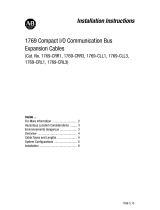 Allen-Bradley 1769 Installation Instructions Manual
Allen-Bradley 1769 Installation Instructions Manual
-
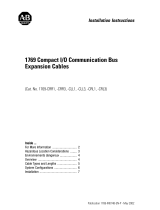 Allen-Bradley 1769-CRL3 Installation Instructions Manual
Allen-Bradley 1769-CRL3 Installation Instructions Manual
-
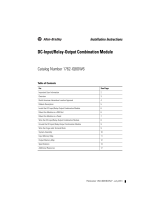 Allen-Bradley 1762-IQ8OW6 Installation Instructions Manual
Allen-Bradley 1762-IQ8OW6 Installation Instructions Manual
-
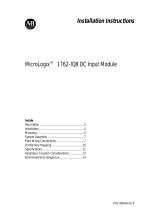 Allen-Bradley MicroLogix 1762-IQ8 Installation Instructions Manual
Allen-Bradley MicroLogix 1762-IQ8 Installation Instructions Manual
-
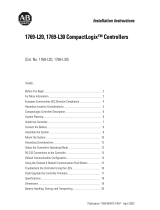 Allen-Bradley CompactLogix 1769-L30 Installation Instructions Manual
Allen-Bradley CompactLogix 1769-L30 Installation Instructions Manual
-
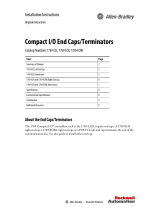 Allen-Bradley 1769-ECR Installation Instructions Manual
Allen-Bradley 1769-ECR Installation Instructions Manual
-
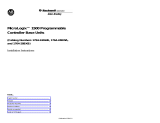 Allen-Bradley Allen-Bradley MicroLogix 1500 1764-28BXB Installation Instructions Manual
Allen-Bradley Allen-Bradley MicroLogix 1500 1764-28BXB Installation Instructions Manual
-
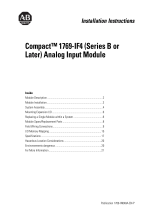 Allen-Bradley Compact 1769-IF4 Installation Instructions Manual
Allen-Bradley Compact 1769-IF4 Installation Instructions Manual
-
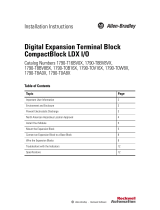 Allen-Bradley 1790-T8BV8BX Installation Instructions Manual
Allen-Bradley 1790-T8BV8BX Installation Instructions Manual
-
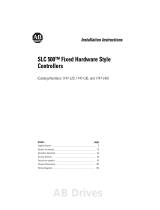 Allen-Bradley SLC 500 1747-L20 Installation Instructions Manual
Allen-Bradley SLC 500 1747-L20 Installation Instructions Manual



























